Урок на тему "Англійські художники"
Form 10 Дата _______
Theme: English painters. Розвиток навичок говоріння
Objectives: to develop pupils’ listening, reading, speaking;
to develop memory, creative thinking;
to develop the responsibility for the group
Equipment: pictures of the painters, saying on the topic “Painters” on the blackboard
Procedure
- Warming-up
T: Dear friends! Look at the blackboard and read the saying
Every artist dips his brush in his own soul, and paints his own nature into his pictures. Henry Ward Beecher
Our pupils have prepared some quotations too. Listen to them:
Painting is just another way of keeping a diary. ~Pablo Picasso
Art is the only way to run away without leaving home. ~Twyla Tharp
Every child is an artist. The problem is how to remain an artist once we grow up. ~Pablo Picasso
Life beats down and crushes the soul and art reminds you that you have one. ~Stella Adler
Painting is silent poetry. ~Plutarch, Moralia: How to Study Poetry
I don't paint things. I only paint the difference between things. ~Henri Matisse
Painting is easy when you don't know how, but very difficult when you do. ~Edgar Degas
Great art picks up where nature ends. ~Marc Chagall
For me, painting is a way to forget life. It is a cry in the night, a strangled laugh. ~Georges Rouault
Every portrait that is painted with feeling is a portrait of the artist, not of the sitter. ~Oscar Wilde
T: Guess the topic of our lesson.
- Main part
T: You are right. Today we are going to speak about painting, English painters
1. Reading
T: Read the text and write out the names of English painters
English Painting has a long and rich history. It is believed that English painting had been influenced by the Celts; however some scholars affirm that real English painting started in the 18th century; this is because the most important painters who worked before in England were foreigners (Hans Holbein the Younger, Anthony van Dyck, etc.), from mainland Europe, and painting was essentially an aristocratic matter (Works from the masters of Italian Renaissance were in the collections of the Earl of Arundel and the Duke of Buckingham). Nineteenth Century, "The Great Century of British Painting", produced a variety of outstanding works. In late XIX century, Sir Lawrence Alma Tadema, a classical-subject Dutch painter, the most successful of the Victorian era, enriched English painting (in some list he appears as English painter). J.M.W. Turner and John Constable influenced not only subsequent generations of British painters, but American and European as well. Portraits and landscape painting have been the great English specialism.
Victorian watercolors (c.1835 - c.1900), was an era in which the English watercolor tradition reach such popularity that everyone from the Royal couple Queen Victoria and Prince Albert to common schoolchildren was "en plain air" painting the English countryside; paintings by W. Turner, David Cox and Peter DeWint increased their prices.
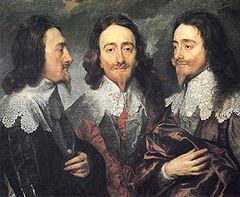
Charles I, King of England, from Three Angles by Anthony van Dyck.
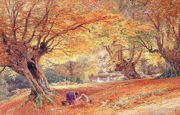
Watercolor: Burnham Beeches by Miles Birket Foster (1825-1899)
2. Project work
Groups present their work about English painters.
I group – Nicolas Hilliard
William Hogarth
Nicholas Hilliard 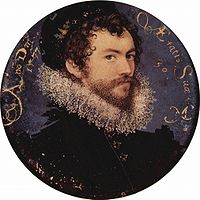
The Elizabethan Nicholas Hilliard (1547-1619), was the most celebrated of English miniaturists. His reputation extended to France. Hilliard was a follower of Hans Holbein. He was also the author of a treatise on miniature painting, "The Art of Limning".
Hilliard was the author of the miniatures of Elizabeth I, 1572, Sir Walter Raleigh, 1585, Elizabeth, Queen of Bohemia, and other members of the courts of Elizabeth I and James I of England.



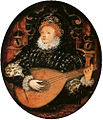

William Hogarth 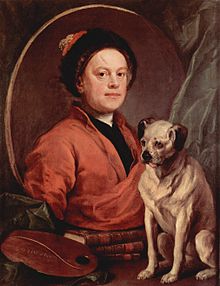
William Hogarth (1697 – 1764) was one of the greatest innovators in English art. He was a professional rebel. He found English art sycophantic, and determined to make it independent. Instead of working for a few rich patrons, he evolved the idea of making his living out of popular engravings of his pictures. He believed that the lack of a native school of painting was largely due to the fashions imposed on a credulous public by connoisseurs and critics and he waged continual war on taste and the Old Masters.
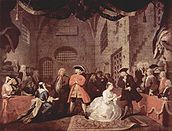
The Beggar's Opera 1731
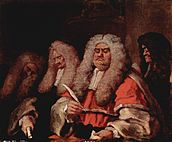
The Bench, 1758
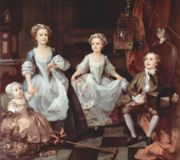
Graham Children.
II group – Sir Joshua Reynolds
Thomas Gainsborough
Sir Joshua Reynolds 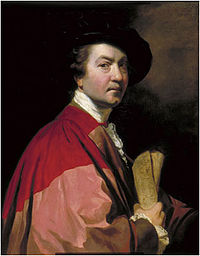
Sir Joshua Reynolds (Plympton, Devon 1723- London 1792) was an English Rococo Painter and distinguished member of London's intellectual society. By 1760, Reynolds had become the most popular portrait painter in London. In 1768, he founded with Thomas Gainsborough the Royal Academy of Arts. In 1784, Reynolds was appointed principal royal portrait painter. He was already been knighted since 1769.
Reynolds' works show an exceptional combination of emotions and technique. Often portraiture with subjects related to Greek and Roman deities, or men, children and women in a wonderful colorist style. Creativity, diversity and originality is present in his painting. Portrait of Nelly O’Brien (Wallace collection) is considered one of his masterpieces.
Since 1912, an statue of him is in the courtyard of the Royal Academy.
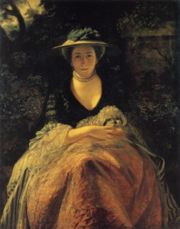
Portrait of Nelly O'Brien

Lady Caroline Howard

Admiral Hood, 1783
Thomas Gainsborough 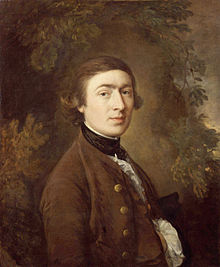
Thomas Gainsborough (Sudbury, Suffolk, 1727 – London, 1788) was a landscape and portrait painter, considered one of the great English masters. In the aristocratic spa town of Bath and later in London, he became well-known for portraits like Mrs. Philip Thicknesse (1760), Mary, Countess Howe (about 1763-4), The Blue Boy (exhibited R.A. 1770), and the landscape The Harvest Wagon (exhibited S.A. 1767). In 1768 he became one of the foundation members of the Royal Academy, at which he exhibited annually until 1784.
In 1780, Gainsborough painted the King George III and Queen Charlotte, becoming the Royal Family's favorite painter. Before his death in 1788, he turned from portraiture to pictorial compositions, producing in all some 200 landscapes in addition to his prolific output of about 800 portraits of the English aristocracy. Gainsborough is the master of the English Rococo.
Sir Joshua Reynolds, President of the Royal Academy, was in painting his most important rival
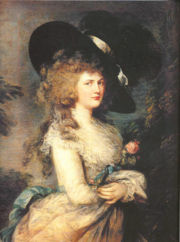
Lady Georgiana Cavendish, 1787.
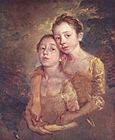
Two Daughters with a Cat (c. 1759)

River Landscape (1768–1770)
III group – Joseph Mallord William Turner
John Constable
William Turner 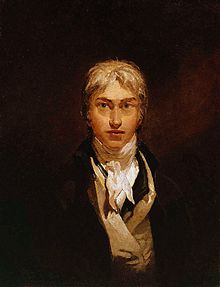
Joseph Mallord William Turner (Covent Garden 1775 - London 1851) was a British Romantic painter. In 1799, he was elected to the Royal Academy where he exhibited watercolors from 1790 to 1820.
In satisfying the fashion for ruins, mountains and waterfalls, he was pleasing and nourishing himself. Ruined abbeys awoke his feelings of history and so charged his mind with the fallacies of hope that this became the title of a chaotic, illiterate epic from which, throughout his life, he quoted mottoes for his pictures. (cf: Clark, Ibidem)
After W. Turner’s death, in 1856, the "Turner Bequest" was settled by a decree; this contains around 300 oil paintings and nearly 30,000 sketches and watercolors by his own hand, all found in his studio.
It is said that Turner created landscape paintings that are revolutionary even today.
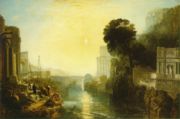
Dido building Carthage, 1815.

Chichester Canal's
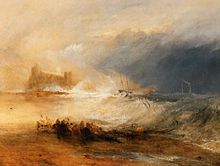
Wreckers Coast of Northumberland, 1836
John Constable 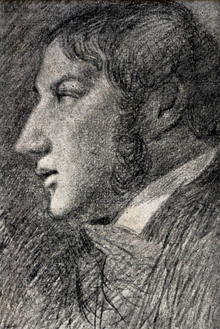
John Constable is today recognised as the major English landscape painter of the 19th century, matched only by his contemporary, J.M.W. Turner (1775-1851). But he was not particularly successful during his lifetime.
Constable, as the son of a prosperous miller, was brought up in one of the most beautiful parts of the English country. "These scenes," said Constable, "made me a painter--and I am thankful". His life had always the intense images of his childhood contemplation, trees, horses, water, clouds. (cf: Clark, Ibidem)
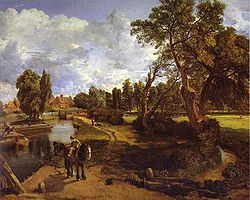 Flatford Mill, 1817
Flatford Mill, 1817
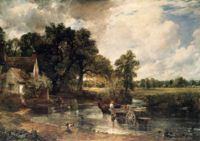
The Hay Wain, 1821.
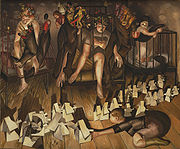
Nursery by Stanley Spencer, 1936
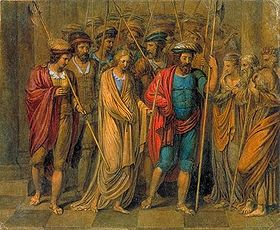
The Penance of Jane Shore by William Blake, 1793.
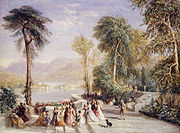
David Cox, Windermere During The Regatta, 1832.
- Summing-up. Home assignment.
T: Overlook the presentation your friends made up. For the next lesson you should be able to speak about one of the English painters painters.


про публікацію авторської розробки
Додати розробку
